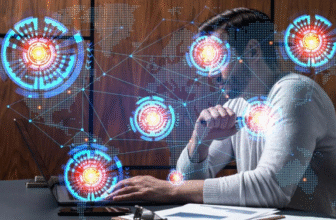
Have you ever seen a security camera and wondered what was taking place inside? This isn’t the only time you’re feeling this way. Whether you’re living in a house, running a shop, or just enjoying learning about technology, knowing how security cameras work can help you keep your belongings and your loved ones safe.
This article aims to simplify it in a way that makes sense. You will comprehend the definition of a security camera system, its function, its components, and its approach to recording and archiving videos. Information that is easy to understand without any confusing words.
What does a security camera system aim to do?
Begin with the fundamentals. The main purpose of a CCTV system is to monitor and record events in a specific location using a group of cameras. Almost everywhere, including homes, stores, schools, and offices, they can be found.
Understanding how it functions is crucial.
Consider CCTV as the equivalent of having extra eyes watching over your area. Control is only possible when you comprehend its operation. You will acquire the ability to detect problems early, like a stranger at your door or a package that has disappeared. Your sense of safety increases when you are aware of what is happening.
Can you give me an overview of the components of a security camera system?
Typically, a complete system consists of:
- Keeping track of events through the use of cameras
- Sending video requires wires or internet connections.
- The video is recorded using a device called a DVR or NVR.
- A device with a screen or phone that allows you to watch the footage.
- The power required to maintain the operation of everything
Sure! You’re rewriting content that’s written in an easy-to-read style that’s suited for someone aged 11 or younger.
What are the components of a security camera system?
These are what’s most important:
- The primary function of cameras is to record everything they see.
- DVR or NVR boxes are designed to save videos for later viewing. DVRs are meant for older analog cameras, while NVRs are meant for newer digital ones.
- To connect the cameras to the recorder and monitor, cables or wireless transmitters are utilized.
- This screen displays what the cameras are seeing.
- Maintaining the system’s operation is the responsibility of the power supply.
These components work as a team to help you keep an eye on your space.
There is a wide range of security cameras to choose from.
Wired vs. Wireless Cameras
- The use of wired cameras involves using cables. Their signal is strong and clear, but it usually requires a professional to install them.
- Wireless cameras have a simpler CCTV installation services process, but their signal may decrease in areas with thick walls.
Indoor vs. Outdoor Cameras
- Small, tidy, and designed for indoor use, indoor cameras are available.
- Outdoor cameras are tough and waterproof, with night vision capabilities to allow for visibility in the dark.
IP vs. Analog Cameras
- Analogue cameras provide options that are both cheaper and simpler. Their job involves employing older-style coaxial cables and basic video.
- IP cameras are designed to be smart and modern. Their use of internet cables results in crisper video quality and additional features.
Can you describe the process of recording video in Security Cameras?
Every camera has a lens and sensor (which can be called CCD or CMOS). The way it works is as follows:
Digital signals are created when light hits the sensor and passes through the lens, similar to how our eyes see things and send messages to our brain. Smart technology is packed into a small box!
What is the process for cameras to send video?
When the camera records something, it must transmit that video to another location. This is the way it travels:
- In older analog systems, coaxial cables are employed.
- Modern IP systems employ Ethernet cables.
- Wi-Fi is used in wireless cameras to send video through the internet.
This enables you to watch what’s happening live or later.
Where does the video travel? (Storage)
The camera needs a storage location after recording video. These are the options that are most frequently chosen:
- DVRs or NVRs contain hard drives that are excellent for saving video locally.
- Watching videos anytime, anywhere with internet is made possible thanks to cloud storage.
- SD Cards, which are small memory cards that can fit inside cameras, are ideal for backups or areas without internet.
Loop recording is available in some systems, which means that if storage is full, it records the oldest videos first. Smart, right?
Absolutely! Your content has been rewritten in a simple and easy-to-understand manner, which is perfect for an average 11-year-old.
What is the process for watching your cameras from anywhere?
Smart apps and the internet have made it possible for you to check your cameras at any time, even when you’re not at home. Here’s what you need to do:
- Stream live video on your mobile device.
- Receive alerts when the camera detects movement.
- Take a look at old recordings from anywhere.
The reason why this works is that every camera has an IP address (just like its home address on the internet). Checking in is possible whenever you want as long as you have access to Wi-Fi or mobile data.
What is the function of motion detecting?
Have you ever noticed a camera light turn on when someone walks by? The motion detection is performing its duty!
Cameras can detect:
- Modifications to pixels (tiny dots on the screen).
- Heat patterns that are similar to the body’s heat.
The camera can start recording or send an alert directly to your phone when it detects motion.
What is the function of DVR and NVR?
Let’s keep it straightforward:
- DVR (Digital Video Recorder)—Works with older-style cameras. It turns video into digital files.
- NVR (Network Video Recorder)—Works with newer IP cameras and gets video over the internet.
Both devices save your videos, let you watch old footage, and help you organize everything. But NVRs usually have more features and better video quality.
How Do Cameras Get Power?
Without power, cameras can’t work! Here are the ways they stay powered:
- Wired Adapters – Plug into the wall, just like your phone charger.
- PoE (Power over Ethernet) – Sends power and video through the same cable. Easy and neat!
- Battery or Solar Power – Great for outdoor or far-away places with no plugs.
How Do Cameras Work at Night?
Even when it’s dark, your cameras can still see! Here’s how:
- Infrared (IR) LEDs – These lights are invisible to people but let cameras “see” in black and white at night.
- Colour Night Vision – Lets you see in colour, even in low light.
- Thermal Cameras – Spot heat, so they can see people or animals even in pitch black.
- Starlight Sensors – Use tiny bits of light (like from stars!) to create clear pictures.
Cool Smart Features in New Cameras
Modern cameras are really smart! They can do more than just record video. Here are some awesome features:
- Face Recognition – Tells you who’s there.
- License Plate Reading – Great for parking lots and driveways.
- Smart Alerts – Uses AI to send you better, more accurate alerts.
- People and Car Counting – Useful in busy places to see how many people or cars passed by.
These smart tools help stop false alarms and make your security super accurate.
How to Pick the Right Camera System
Before you buy anything, ask yourself these questions:
- Is it for indoors or outdoors?
- Do you need it to see in the dark?
- How many cameras do you want?
- Do you want to check your cameras remotely?
- What’s your budget?
Answering these will help you find the system that fits you best.
Conclusion
Knowing how a security camera system works helps you make better choices. From the moment something moves to when you get an alert on your phone, every part of the system works together to keep you safe. Whether it’s wired or wireless, old-school or smart, when you understand what’s going on behind the scenes, you’re always one step ahead.







